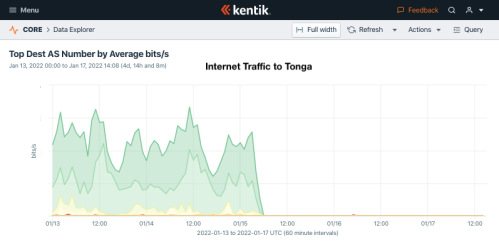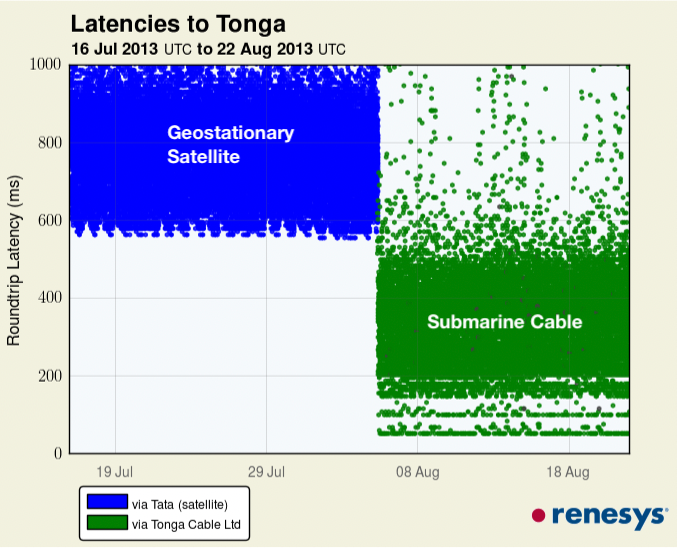Tonga downed by massive undersea volcanic eruption


Summary
On Saturday, the pacific island nation of Tonga was decimated by a massive volcanic eruption that was visible from space. At 5:27pm local time, the underwater volcano Hunga Tonga-Hunga Ha’apai unexpectedly erupted, sending ash and debris for hundreds of miles. As of this writing, all internet and telephone communications between Tonga and the rest of the world are still down.
On Saturday, the pacific island nation of Tonga was decimated by a massive volcanic eruption that was visible from space. At 5:27pm local time, the underwater volcano Hunga Tonga-Hunga Ha’apai unexpectedly erupted, sending ash and debris for hundreds of miles. As of this writing, all internet and telephone communications between Tonga and the rest of the world are still down.

As I tweeted out on Saturday, based on Kentik aggregate NetFlow data, we observed a steep dropoff in traffic to Tonga at 5:30pm local time (just a couple of minutes after the eruption) and later a complete disconnection at 6:40pm local time in Tonga.

In the days since the volcanic eruption, it has been confirmed that the submarine cable connecting Tonga to the global internet was broken approximately 37 km from shore. The submarine cable repair ship that will likely be tasked with making the repair will be the CS Reliance. Given that the Reliance is still docked at Port Moresby in Papua New Guinea, it might not be until the end of the month before the repairs are made.
Activation of the Tonga Cable
Connecting remote island nations with high-speed access to the global internet is one of the great challenges of the modern internet. Without a submarine cable, these locations are reliant on satellite service which is expensive, suffers from higher latency (at least for geostationary satellite service), and is capacity constrained (as compared to fiber optic cable).
Satellite service in the Pacific is expensive because the coverage area is vast and the populations are relatively small. There isn’t an economy of scale to bring down the price of service.
In the submarine cable industry, connections to these locales are referred to as “thin routes” - meaning the return on investment for constructing a submarine cable would likely be very small or thin. Given the risk involved in funding, fabricating and installing a submarine cable, private investors generally pass.
Several attempts at cost control have been made to connect islands in the Pacific Ocean including using a “donor cable”. In this scenario a submarine cable is carefully retrieved off the ocean floor and relaid (“donated”) to connect another island. The old cable may no longer have the capacity for its previous route, but might be more than enough for its new one. The donated cable eliminates fabrication costs, which can be half of the cost of a new submarine cable.
In 2011, the World Bank Group and the Asian Development Bank announced that they would fund a new submarine cable to Tonga. In a press release, World Bank Group President Robert B. Zoellick stated that:
“Access to high-speed internet links will vastly improve opportunities for the people of Tonga to connect to the world, provide information needed by business to expand jobs, and allow people to more easily and inexpensively keep in contact with families overseas…
This critical link will connect Tonga firmly with the rest of the world, generating huge economic opportunities from early 2013 when the cable should be in place and marking a key step in Tonga’s international connectivity.”
At 5:56 UTC on August 5, 2013, I spotted the activation of the Tonga cable based on traceroute measurements. My presentation the following month at Submarine Networks World in Singapore included the graphic below showing the dramatic improvement in latency from geostationary satellite to subsea cable. Like Cuba earlier that year, Tonga was now connected via submarine cable and its reliance on slow, expensive satellite service was over.

In January 2019, the Tonga Cable was severed by a ship’s anchor (the most common way submarine cables are broken). Tonga reverted to satellite but had to limit certain types of communication due to the limited capacity of the satellite signal.
The emergency activation of satellite service in 2019 led to an unresolved legal dispute between the regional satellite operator Kacific and the Tongan government-owned company, Tonga Satellite. Despite the impasse, Kacific has offered to work to reconnect Tonga given the current circumstances. Normally restoring a satellite link would be faster than fixing a broken submarine cable but there remain a lot of unknowns, such as the state of the island’s telecommunications infrastructure following the tsunami.
How could an undersea volcano have taken out a submarine cable?
Undersea landslides are a danger to subsea cables, and in the Pacific this has been the cause of some famous outages in the past. Professor Lionel Carter of the Victoria University of Wellington has written about how submarine landslides and turbidity currents pose threats to subsea cables.
In December 2006, an earthquake in Taiwan caused underwater landslides that disrupted numerous cables crippling communications in the Far East. The earthquake caused 21 faults in 9 cables and took 11 ships to restore everything back to normal.
Then again in March 2011, a magnitude 9.1 earthquake off the coast of Japan that led to underwater landslides that carried one submarine cable 2km according to a panel discussion at Suboptic in April 2013.
According to our data, we observed the complete disconnection of Tonga at 6:40pm local time. This was over an hour after the initial drop in traffic immediately followed the eruption. We will soon learn whether this was the time necessary for an underwater landslide to reach the Tonga cable causing the break.
We will be following the situation in Tonga and be hoping for a quick and safe recovery for everyone there.